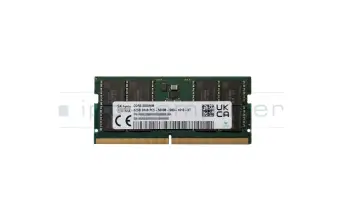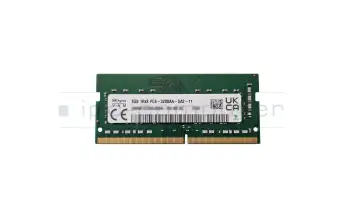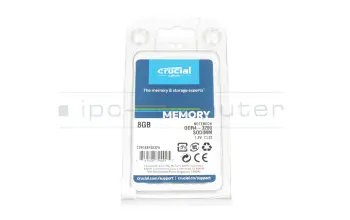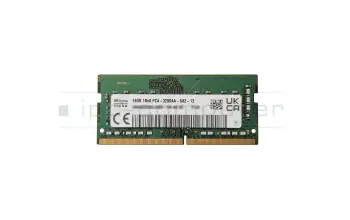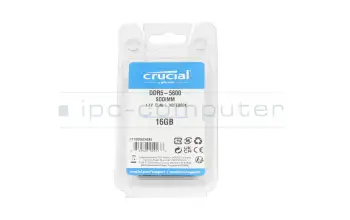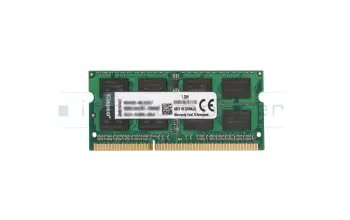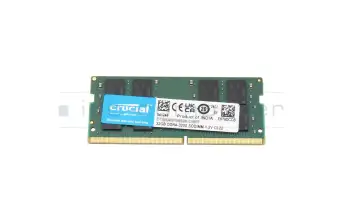Mémoire de l'ordinateur portable / RAM
Pourquoi acheter la mémoire de travail chez IPC-Computer?
- Notre assurance qualité garantit une utilisation sûre
- Nouveau maintenant! Nos mémoires de la nouvelle marque Asus JoGeek
- Notre module de recherche RAM permet de trouver rapidement et facilement la bonne mémoire RAM
- Support technique gratuit pour tous les problèmes de mémoire

Trouver la bonne batterie en fonction du modèle ou des caractéristiques
Crucial CT32G4SFD832A mémoire vive 32GB DDR4-RAM

plus frais d'expédition
Substitut pour Samsung 5M30Z71646 mémoire vive 8GB DDR4-RAM

plus frais d'expédition
Kingston KVR16LS11/8 mémoire vive 8GB DDR3L-RAM

plus frais d'expédition
Kingston KCP3L16SD8/8 mémoire vive 8GB DDR3L-RAM

plus frais d'expédition
Crucial CT8G4SFRA32A mémoire vive 8GB DDR4-RAM

plus frais d'expédition
Substitut pour Micron MTA4ATF1G64HZ-3G2F1 mémoire vive 8GB DDR4-RAM

plus frais d'expédition
Crucial CT16G4SFD832A mémoire vive 16GB DDR4-RAM

plus frais d'expédition
Crucial CT16G4SFRA32A mémoire vive 16GB DDR4-RAM

plus frais d'expédition
Kingston KF556S40IB-16 mémoire vive 16GB DDR5-RAM

plus frais d'expédition
Substitut pour Samsung M393B1K70QB0-YK0 mémoire vive 8GB DDR3-RAM DIMM utilisé

plus frais d'expédition
Ce à quoi vous devez faire attention lors de la mise à niveau de la RAM
Tout d'abord, il faut vérifier si une extension de RAM est possible. Pour vérifier cela, vous avez besoin de regarder à l'intérieur de l'ordinateur portable. Certains modèles d'ordinateurs portables ont une ouverture, cependant il peut arriver que tout le dessous de l'appareil doit être retiré.
Vous devriez maintenant savoir si les modules existants sont soudés ou si un emplacement est disponible. Une expansion de la mémoire principale est possible, seulement si un emplacement est disponible. S'il n'y a pas d'emplacement libre, il est toujours possible de remplacer un module RAM existant par un module d'une capacité supérieure.
Si une mise à niveau de la RAM est possible, il faut encore vérifier quelle capacité les nouveaux SO-DIMM sont autorisés à avoir. La mémoire totale moins la mémoire déjà installlée entraîne la plus grande expansion possible de la mémoire. Exemple: Supposons que votre ordinateur portable puisse traiter un maximum de 20 Go. Il y a déjà 12 Go installés. Cela signifie que la capacité de stockage disponible dans ce cas est de 8 Go.
Interesting articles on the subject of notebook RAM memory
Ainsi, vous pouvez trouver rapidement la bonne mémoire
Les ordinateurs portables ne nécessitent que le type de mémoire RAM SO-DIMM. Pour trouver la bonne RAM, vous avez la possibilité de rechercher avec votre modèle d'ordinateur portable ou via notre recherche RAM.
Pour trouver une mémoire adaptée à votre modèle, veuillez chercher les informations de l'appareil sur l'étiquette de votre ordinateur portable. Nous vous montrons ici, où vous pouvez les trouver. Ensuite, vous pouvez voir les articles appropriés dans la catégorie mémoire de travail.
Alternativement, vous pouvez naviguer vers la mémoire appropriée via la recherche RAM. Grâce au filtre, vous pouvez trouver rapidement la mémoire que vous recherchez. Il peuvent êtres filtrée par capacité, type de mémoire, timing (vitesse) ainsi que beaucoup d'autres valeurs. Si vous ne connaissez pas les données techniques requises de votre mémoire principale, notre article FAQ peut vous aider. Nous vous montrons quels outils vous pouvez utiliser pour déterminer si vous avez un type de mémoire DDR3, DDR3L ou DDR4 et comment lire les autres spécifications.
Tous les ordinateurs portables de qualité modernes utilisent aujourd'hui un fonctionnement à deux canaux, l'opération dite à deux canaux. Par conséquent, il serait avantageux si les modules de mémoire proviennent du même fabricant et ont la même capacité ainsi que le même timing. Cela peut sinon provoquer des problèmes de fonctionnement dans les deux canaux.
Laptop RAM FAQ
Here you can find all questions and answers surrounding laptop RAM
- Comment ouvrir mon ordinateur portable dans les règles de l'art et à quoi dois-je faire attention lors du remplacement de la RAM ?
L'ouverture d'un ordinateur portable requiert du soin, les bons outils et un peu d'expérience.
Pour éviter d'endommager le matériel, tu dois respecter ces règles de base :
- Sécurité : déconnecte complètement l'appareil du courant et retire si possible la batterie ou coupe le courant via le BIOS.
- Outils : n'utilise que des outils de mécanique de précision appropriés et veille à disposer d'une protection ESD (antistatique) pour éviter les décharges électroniques.
- Procédure à suivre : Dévisse systématiquement les vis du boîtier et soulève délicatement le couvercle de fond à l'aide d'un outil plat en plastique (spudger).
- Attention : ne force jamais. De nombreux appareils possèdent des vis cachées sous des pieds en caoutchouc ou des autocollants.
Dans notre série "Mon ordinateur portable vu de l'intérieur" nous montrons clairement comment sont construits les différents modèles d'ordinateurs portables et quelles sont les étapes nécessaires pour les ouvrir en toute sécurité. Les vidéos t'aident à mieux comprendre la construction de différentes marques (par ex. HP, Lenovo, Dell, Acer) et montrent où se trouvent la batterie, la carte mère ou la RAM.
- Voici la série de vidéos : Mon ordinateur portable vu de l'intérieur (YouTube)
Si tu as des doutes quant à l'ouverture ou si tu possèdes des composants fixes, nos collaborateurs se chargent de l'ouverture. techniciens de l'atelier se chargent du démontage et de la réparation en toute sécurité.
- De quelle mémoire RAM ai-je besoin pour mon ordinateur portable ?
Pour que la mémoire vive soit vraiment adaptée, tu dois connaître trois points :
- Type de RAM et type de construction
Ton ordinateur portable supporte par exemple :- DDR3, DDR4 ou DDR5.
- Elles doivent impérativement être de type SO-DIMM (modules pour ordinateur portable, pas DIMM pour ordinateur de bureau).
Un autre type (par exemple DDR5 au lieu de DDR4) ne fonctionne pas techniquement.
- Taille maximale et fréquence d'horloge
Chaque ordinateur portable a :- une capacité totale maximale de RAM (p. ex. 16, 32 ou 64 Go),
- une fréquence d'horloge spécifique (par exemple DDR4-2666, DDR4-3200, DDR5-4800).
La nouvelle RAM doit correspondre à ces spécifications. Si tu laisses les modules existants dans l'appareil, l'idéal est de rajouter la même fréquence et la même capacité. Le choix d'une fréquence d'horloge plus élevée est souvent possible, mais n'est pas optimal pour les performances du système.
- Nombre et occupation des slots
Ce qui est important :- Combien de slots de RAM ton ordinateur portable possède-t-il (généralement 1-2) ?
- Combien sont déjà occupés et avec quelle taille (par ex. 1×8 Go, 2×4 Go) ?
- Attention: sur plus de 10.000 ordinateurs portables, la RAM est soudée et non pas enfichée - elle ne peut donc pas non plus être étendue.
Notre conseil pratique :
Grâce à notre navigation par fabricant/modèle dans la boutique IPC, tu trouveras très facilement la RAM qui te convient. Il te suffit de sélectionner le fabricant → la série → le modèle exact - seuls les modules RAM compatibles, qui correspondent techniquement à ton ordinateur portable et qui ont fait leurs preuves dans la pratique, s'affichent alors. Tu minimises ainsi le risque de mauvais achats et d'incompatibilités.- Accès direct au Finder :Configurateur de mémoire de travail IPC
- Aide en cas de questions :Formulaire de contact IPC Computer
- Type de RAM et type de construction
- Dois-je choisir la même fréquence MHz lors de la mise à niveau si la RAM existante doit rester dans l'ordinateur portable ?
Dans l'idéal, oui.
Si tu veux continuer à utiliser la RAM existante et seulement la compléter, tu dois tenir compte des points suivants :
- Le même MHz/cadence est clairement préférable.
Les modules fonctionnent alors proprement à la même vitesse, ce qui favorise la stabilité et les performances. - Des cadences différentes sont généralement possibles, mais sous-optimales.
Dans la pratique, le système abaisse alors la fréquence de tous les modules à la vitesse commune la plus basse.
Risques :- risque légèrement plus élevé d'instabilité (écrans bleus, freezes),
- dans le pire des cas, la nouvelle RAM n'est même pas reconnue correctement.
- En cas de doute : s'aligner sur la RAM existante.
Si ta RAM actuelle est par exemple à 2666 MHz, le mieux est d'acheter à nouveau 2666 MHz - ou un module plus rapide qui est officiellement rétrocompatible et qui peut fonctionner de manière fiable à 2666 MHz.
Trouver une mémoire adaptée
Pour éviter les incompatibilités, tu peux utiliser directement notre IPC-RAM-Finder. Après avoir sélectionné ton modèle d'ordinateur portable, tu y trouveras la mémoire garantie adaptée.
- Le même MHz/cadence est clairement préférable.
- Mise à niveau de la RAM sans succès : que faire si la mémoire n'est pas reconnue ?
Si ton ordinateur portable ne démarre pas après l'installation ou si la nouvelle mémoire ne s'affiche pas, tu dois procéder comme suit :
- Vérifier la compatibilité :
Le type (DDR3, DDR4, DDR5), la fréquence d'horloge, le type de construction (SO-DIMM) et la tension doivent correspondre exactement à l'ordinateur portable. Conseil : utilise la recherche de modèle du fabricant ou notre IPC-RAM-Finder pour t'en assurer. - Contrôler l'installation :
Éteindre l'ordinateur portable, débrancher la batterie, enclencher le module en exerçant une légère pression. Souvent, il n'est pas bien placé dans le slot. - Tester les slots individuellement :
Essayer les modules RAM individuellement dans chaque slot ; exclure le slot ou le module défectueux. - Mettre à jour le BIOS/UEFI :
Un BIOS obsolète ne reconnaît souvent pas les nouvelles générations de RAM. Installe la dernière mise à jour directement depuis le site web du fabricant de l'ordinateur portable. - Ne pas mélanger indifféremment ancienne et nouvelle RAM :
Des cadences et des timings différents provoquent souvent des problèmes de démarrage.
Besoin d'aide ? Si vous avez vérifié toutes les étapes et que l'erreur persiste, veuillez contacter l'équipe de service IPC-Computer par mail ou par chat. Nos techniciens t'aideront à trouver une solution au problème et à la mettre en œuvre conformément à la promesse de solution d'IPC.
- Vérifier la compatibilité :
- Mon Windows se bloque ou l'image se fige : Ma mémoire vive est-elle défectueuse ?
Cela peut être dû à la mémoire vive, mais pas nécessairement. Les pannes et les blocages sont des symptômes typiques de la RAM, mais pas évidents.
Signes typiques d'un éventuel défaut de la RAM :
- Écrans bleus avec des messages d'erreur changeants ou "aléatoires".
- Gel en charge (jeux, montage vidéo, nombreux onglets/programmes)
- Problèmes de démarrage : Des plantages se produisent déjà peu après le démarrage de Windows.
- Redémarrages : l'ordinateur portable redémarre sans raison apparente ni avertissement.
Autres causes possibles :
- pilotes ou mises à jour Windows défectueux
- CPU/GPU en surchauffe
- SSD/HDD défectueux
- alimentation électrique ou bloc d'alimentation instable
Ce que tu peux tester toi-même :
- Exécuter le diagnostic de la mémoire Windows
Via "Diagnostic de la mémoire Windows" → Redémarrer → Lancer le test. - Memtest (par ex. MemTest86)
Démarrer à partir de l'USB et laisser la mémoire être testée en détail. - Tester les modules un par un
Si plusieurs barres de RAM sont installées : n'en insérer qu'une à la fois et vérifier si l'erreur se produit avec un module donné.
Si les tests signalent des erreurs ou si le système se bloque toujours avec une barre RAM donnée, la mémoire vive est très probablement défectueuse.
Si tu n'es pas sûr ou si l'appareil est important pour ton travail, nous te recommandons de faire établir un diagnostic professionnel dans notre atelier. Là, nos techniciens peuvent faire une distinction précise entre les problèmes de RAM, les erreurs de carte mère ou les conflits de logiciels.
- Trouver un remplacement :Mémoire vive d'origine dans la boutique IPC
- Demander un diagnostic :Notebook Doktor Service d'atelier
- Pourquoi les prix de la RAM et de la mémoire sont-ils actuellement si élevés et la disponibilité si mauvaise ?
La raison principale est une pénurie mondiale sur le marché de la mémoire vive. Celle-ci résulte pour l'instant principalement de deux évolutions :
- Une demande massive du secteur de l'IA/des serveurs
Une très grande partie de la production mondiale de mémoire est actuellement achetée pour le matériel d'IA, les centres de calcul et les serveurs à haute performance. Selon les estimations , plus de 40 % de la production mondiale de DRAM est désormais destinée à ce secteur.
Cela signifie qu'il reste nettement moins de marchandises pour les modules RAM classiques des PC et des ordinateurs portables - ce qui entraîne une pénurie et une forte hausse des prix d'achat. - Retrait ou consolidation des fabricants et des marques
Parallèlement, on assiste à des épurations du marché et à des changements de fabricants. Des marques qui étaient très présentes sur le marché des consommateurs finaux - par exemple Crucial - disparaissent partiellement ou totalement de certains segments ou marchés. Le nombre réduit de fournisseurs, alors que la demande reste élevée, aggrave encore la pénurie.
La combinaison de ces deux facteurs fait que :
- certaines variantes de RAM ne sont plus disponibles que de manière limitée, voire plus du tout,
- les prix des modules disponibles augmentent parfois très rapidement et de manière significative,
- il est actuellement plus difficile de planifier et de se procurer de la RAM de remplacement et de mise à niveau pour les ordinateurs portables.
Conseil pratique :
Nous essayons d'assurer au mieux l'approvisionnement de nos clients en achetant tôt et largement ainsi que des produits alternatifs techniquement équivalents. Nous ne pouvons toutefois pas nous soustraire complètement à la situation globale du marché - les hausses de prix et les disponibilités limitées proviennent directement de cette situation de pénurie sur le marché du stockage et de l'IA. - Une demande massive du secteur de l'IA/des serveurs
- Pourquoi mon ordinateur portable affiche-t-il moins de mémoire que ce que j'ai installé ?
Il y a plusieurs raisons pour lesquelles ton ordinateur portable affiche moins de RAM que ce que tu as réellement installé. Voici les principales causes :
- Une partie de la RAM est réservée pour le graphique
En particulier avec le graphique intégré (iGPU), une partie de la RAM est utilisée comme mémoire vidéo (par ex. 512 Mo, 1 Go ou plus).
→ Exemple : Si 16 Go sont installés et que seuls 15 Go environ sont affichés, le reste se trouve dans la zone "réservé au matériel". - Système d'exploitation 32 bits
Un Windows 32 bits ne peut techniquement adresser qu'environ 3-3,5 Go de RAM - quelle que soit la quantité installée.
→ Solution : passer à un Windows 64 bits (si le matériel le supporte). - Paramètres du BIOS/UEFI
Certains paramètres du BIOS/UEFI (remappage de la mémoire, mémoire réservée pour les périphériques) peuvent faire en sorte que toute la RAM ne soit pas disponible pour Windows. - L'une des barrettes de RAM n'est pas reconnue correctement.
- le module n'est pas correctement positionné dans le slot (pas complètement enclenché)
- un slot est défectueux
- un module de RAM est défectueux ou incompatible
→ Dans ce cas, il n'est par exemple affiché que 8 Go au lieu de 16 Go.
- Différence entre "installé" et "utilisable"
Dans Windows, tu vois souvent : "Installé : 16,0 Go (utilisable : 15,2 Go)"
C'est tout à fait normal, car une petite partie reste toujours fermement réservée pour le système et le matériel.
Ce que tu peux vérifier toi-même :
- Dans Windows, sous Gestionnaire des tâches → Performances → Mémoire:
- "Installé" vs "utilisable".
- Indication "Réservé pour le matériel"
- Dans le BIOS/UEFI : la quantité totale de RAM y est-elle reconnue ?
- Tester les modules de RAM individuellement : insérer chaque barre séparément et vérifier la quantité reconnue.
Tu as besoin d'aide ?
Si les affichages ne sont toujours pas clairs ou si tu as un problème technique, nous t'aiderons volontiers personnellement. Tu peux nous envoyer tes données système exactes et le modèle de ton ordinateur portable via notre formulaire.
- Accès direct au support : formulaire de contact IPC Computer
- Trouver des pièces de rechange : Mémoire vive d'origine dans la boutique
- Une partie de la RAM est réservée pour le graphique
- Puis-je étendre ma mémoire de travail moi-même ?
Oui, ce n'est pas sorcier ! Tu as seulement besoin d'outils adaptés et d'un peu de savoir-faire technique, et éventuellement d'une brève instruction sur la manière d'ouvrir l'appareil.
Voici comment tu dois procéder
Dans la plupart des cas, il faut dévisser la plaque de fond de l'ordinateur portable pour accéder à la mémoire vive. Pour cela, notre série de vidéos "Mon ordinateur portable vu de l'intérieur" peut te rendre de précieux services. Nous y montrons étape par étape comment ouvrir différents modèles de manière professionnelle.
- Cliquez ici pour accéder aux instructions : Mon ordinateur portable vu de l'intérieur (YouTube)
Remarque importante concernant la mémoire soudée
Veuillez noter que sur de nombreux appareils récents, la totalité ou au moins une partie de la mémoire vive est soudée sur la carte mère. Dans ce cas, un échange ou une extension n'est malheureusement pas possible techniquement. Grâce à notre Shop Finder, tu peux vérifier au préalable si ton modèle dispose d'emplacements libres.
Notre service d'atelier
Tu peux volontiers confier l'installation à nos spécialistes. Il te suffit de nous envoyer ton appareil. Nous garantissons un montage soigné, y compris un contrôle fonctionnel final.
- Demander une réparation : Formulaire de réparation d'ordinateur IPC
- Accès direct à la boutique : trouver la RAM adaptée à ton modèle
- Puis-je installer d'autres modules de mémoire dans mon ordinateur portable que la mémoire vive déjà installée ?
Oui, c'est en principe possible. Tu dois toutefois respecter des limites techniques claires. Pour que la mise à niveau soit réussie, tu dois veiller aux points suivants :
- Type de RAM :
La nouvelle mémoire vive doit correspondre au type supporté par ton ordinateur portable (par ex. DDR3, DDR4 ou DDR5 en SO-DIMM). Un autre type ne fonctionnera pas techniquement, même s'il semble mécaniquement similaire. - Cadence et timing :
Il est souvent possible de mélanger des cadences différentes ; dans la pratique, toute la mémoire fonctionne alors à la cadence du module le plus lent. Certaines combinaisons peuvent toutefois entraîner des instabilités. - Exploitation mixte :
Il est souvent possible d'exploiter ensemble différents fabricants, tailles et cadences. Mais il est techniquement plus propre et généralement plus stable de miser sur des modules compatibles entre eux (idéalement un kit). - Capacité maximale :
Tu ne dois pas dépasser la taille maximale de RAM par slot et au total prescrite par le fabricant de l'ordinateur portable.
Recommandation :
Si tu ajoutes de la mémoire vive, choisis idéalement des modules de même capacité et de même fréquence. Le plus sûr est de vérifier via notre recherche de modèles quels modules sont expressément autorisés pour ton ordinateur portable. Tu minimiseras ainsi le risque de problèmes de démarrage ou de crash.- Contrôle de modèle : trouver la RAM adaptée dans la boutique IPC

- Type de RAM :
- Quelle est la fréquence d'horloge de la mémoire vive que j'utilise actuellement ?
Tu peux facilement trouver toi-même la fréquence d'horloge de ta mémoire vive. Comme ces valeurs varient d'un modèle à l'autre, tu dois les lire directement sur l'appareil.
Voici comment trouver la fréquence d'horloge de la RAM sous Windows :
- Via le gestionnaire de tâches (rapide, mais approximatif)
- Clic droit sur la barre des tâches → Gestionnaire de tâches
- Onglet "Performances " → "Mémoire vive".
- En haut à droite, tu peux voir : "Vitesse" (par exemple 2666 MHz, 2933 MHz, 3200 MHz, 4800 MHz).
- Via un outil comme CPU-Z (plus précis)
- Télécharger l'outil CPU-Z et le lancer.
- Onglet "Memory" :
- Sous "DRAM Frequency", on trouve par exemple 1333 MHz → pour la DDR4, cela correspond effectivement à 2666 MHz (toujours doubler, car DDR = Double Data Rate).
- Onglet "SPD" :
- Ici, tu peux voir par slot quelle barre de RAM est montée, y compris la fréquence spécifiée (par ex. DDR4-3200).
- Via le BIOS/UEFI (selon le fabricant)
- Au démarrage, aller dans le BIOS/UEFI (souvent F2, F10, Suppr).
- Dans les zones "Advanced"/"System Information", la fréquence de la RAM ou la vitesse effective est souvent affichée.
Remarque importante à ce sujet :
- Pour la DDR4, les fréquences typiques des ordinateurs portables sont par exemple 2133, 2400, 2666, 2933, 3200 MHz.
- Pour la DDR5 dans les ordinateurs portables, les fréquences actuelles sont par exemple 4800, 5200, 5600 MHz.
- Si tu as mélangé des modules avec des cadences différentes, la RAM fonctionne en général avec la vitesse commune la plus faible.
Si tu n'es pas sûr de savoir quelle mise à niveau convient à ta mémoire actuelle, nous t'aiderons volontiers. Pour cela, il te suffit de nous envoyer ton modèle d'ordinateur portable ou les valeurs que tu as lues via notre formulaire de contact. Tu peux aussi y télécharger facilement des captures d'écran de tes évaluations. Nos techniciens vérifieront alors la compatibilité optimale pour toi.
- Accès direct au support : Formulaire de contact IPC Computer
- Trouver la RAM qui convient : Boutique IPC

- Via le gestionnaire de tâches (rapide, mais approximatif)
- Quelle quantité de mémoire vive mon ordinateur portable peut-il contenir ?
La quantité de mémoire vive que peut contenir ton ordinateur portable dépend toujours du modèle concret. Mais tu peux le savoir assez facilement.
1. via les indications du fabricant / le manuel
- Regarde dans :
- le manuel d'utilisation de ton ordinateur portable
- ou sur le site d'assistance du fabricant (entrer le modèle → "Spécifications" ou "Mémoire/RAM").
- Tu y trouveras en général :
- capacité totale maximale (par ex. 16 Go, 32 Go, 64 Go),
- nombre de slots de RAM (par ex. 1 ou 2),
- type de RAM pris en charge (par exemple DDR4-3200 SO-DIMM, DDR5-4800 SO-DIMM).
2. à l'aide d'outils sous Windows
- Avec des outils comme CPU-Z ou HWiNFO, tu peux lire :
- combien de slots sont disponibles,
- combien d'entre eux sont occupés,
- quels modules sont actuellement installés (taille, type, fréquence).
- La taille maximale absolue n'y figure pas toujours, mais elle aide à l'estimation (par ex. 2 slots, 8 Go chacun installés → aujourd'hui 16 Go, souvent possible : 2×16 Go = 32 Go).
3. via une recherche de modèle dans le Boutique IPC
Moyen pratique pour toi en tant que client IPC :
- Cherche dans la boutique le fabricant de ton ordinateur portable + le modèle.
- Dans les articles de RAM correspondants, tu trouveras généralement des indications telles que :
- "32 Go max. pris en charge".
- "2 slots, dont 1 libre".
- Tu peux ainsi voir directement :
- quels modules sont compatibles,
- jusqu'à quelle taille ton appareil peut être mis à niveau de manière judicieuse.
Attention : sur plus de 10.000 modèles d'ordinateurs portables, il n'est plus possible d'échanger la mémoire, car la RAM est soudée sur la carte mère.
See also: - Regarde dans :
- Quelles sont les informations les plus importantes lors de l'achat de mémoire vive ?
Lors de l'achat de RAM pour ton ordinateur portable, certains points sont essentiels pour que la mémoire soit parfaitement adaptée et constitue un investissement judicieux :
- Type de RAM compatible
Ton ordinateur portable ne supporte que certains types de RAM, par exemple DDR4 ou DDR5, tous deux sous forme de SO-DIMM (forme de construction de l'ordinateur portable). Un type incorrect ne s'adapte techniquement pas au slot. - Capacité maximale & slots
Chaque ordinateur portable a une taille totale maximale de RAM et généralement 1 à 2 slots. Avant l'achat, tu devrais clarifier :- Quelle est la quantité de RAM actuellement installée ?
- Combien de slots sont libres ?
- Quelle est la quantité maximale de RAM supportée par ton modèle ?
C'est ce qui te guidera dans ton choix de 8, 16, 32 Go ou plus.
- Cadence & compatibilité
La nouvelle RAM doit correspondre à la fréquence d'horloge de ton système, par exemple 3200 MHz ou 5200 MHz. Il est souvent possible d'utiliser des modules plus rapides, mais ils fonctionnent alors automatiquement à la fréquence plus faible de ta carte mère. Un mélange de différents modules peut fonctionner, mais il est plus sujet aux erreurs qu'un ensemble uniforme. - Domaine d'utilisation
- Bureau et Internet : Dans ce cas, 8 à 16 Go suffisent généralement.
- Jeux et traitement d'images : 16 à 32 Go sont recommandés.
- Vidéo, CAO et travail professionnel : Ici, tu profites de 32 Go ou plus.
- Vérifier la possibilité de mise à niveau
Sur de nombreux ultrabooks actuels, la RAM est soudée et ne peut pas être remplacée ou étendue. Avant l'achat, tu dois absolument vérifier si ton ordinateur portable peut être mis à niveau.
Conseil :
Utilise une recherche ciblée de modèles/un contrôle de compatibilité (par ex. via notre boutique par fabricant/modèle). Tu verras alors directement quels modules de RAM sont techniquement autorisés et quelle est la quantité de mise à niveau raisonnable et possible pour ton ordinateur portable. - Type de RAM compatible
- Sous Windows 11, où puis-je trouver les informations sur la mémoire installée ?
Sous Windows 11, tu peux le vérifier à plusieurs endroits. Les deux façons les plus simples :
1. via les paramètres
- Clique sur Démarrer → Paramètres.
- Va dans Système → À propos.
- Sous Spécifications du périphérique, tu trouveras l'entrée RAM installée (par exemple "16,0 Go").
2. via le gestionnaire de tâches
- Ouvrir le gestionnaire de tâches avec Ctrl + Shift + Esc.
- Cliquer sur l'onglet Performances.
- Sélectionner à gauche Mémoire de travail.
- En haut à droite se trouve la taille totale (par ex. "16,0 Go") et en dessous la quantité qui est actuellement utilisée.
Notre conseil pour ta mise à niveau
Si l'affichage révèle une utilisation élevée de ta mémoire, une extension peut améliorer sensiblement les performances de ton ordinateur portable. Dans notre boutique, tu trouveras à coup sûr des modules compatibles avec ton modèle.

- Une extension de la mémoire vive rend-elle mon ordinateur portable plus rapide ?
Oui, dans de nombreux cas. Mais cela ne vaut que si ta RAM actuelle est le facteur limitant.
Une extension de la RAM t'apporte une plus grande vitesse, surtout si les points suivants s'appliquent :
- ton ordinateur portable est souvent très sollicité (utilisation élevée de la RAM dans le gestionnaire de tâches),
- les programmes ou les navigateurs avec de nombreux onglets réagissent lentement,
- Windows se recharge sensiblement , est saccadé ou se fige lorsque tu utilises plusieurs applications en parallèle,
- le disque dur/SSD travaille en permanence, même si tu ne fais rien de gros (fort déstockage par manque de RAM).
Les effets positifs après l'extension :
- Les programmes démarrent et fonctionnent de manière nettement plus fluide.
- Tu peux utiliser plus d'applications en même temps sans perte de performance.
- Il y a nettement moins d 'externalisation sur le disque dur ou le SSD, plus lent.
L'effet est moins perceptible si tu :
- tu as déjà suffisamment de RAM (par ex. 16-32 Go pour une utilisation purement bureautique/surf),
- ton système est plutôt freiné par un disque dur lent ou une unité centrale/graphique faible.
Conseil pratique :
Si tu n'es pas sûr qu'une extension de la RAM en vaille vraiment la peine pour ton modèle, tu peux non seulement trouver la RAM adéquate via notre navigation fabricant/modèle dans la boutique IPC, mais tu peux aussi voir si une mise à niveau est possible.Sur de nombreux ordinateurs portables modernes, la RAM est soudée sur la carte mère.
